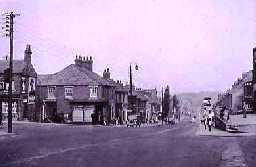Local History
Coxhoe (County Durham)
The earliest artefact to be found in the area is a simple Bronze Age axe. Despite this early find there are few other remains from before the medieval period, although the Roman road known as Cade's Road does run through the parish.
The area only really developed in the medieval period. As well as the village of Coxhoe itself, another, now deserted, village also grew up at Coxhoe East House. However, this village was probably deserted by the early 15th century.
Coxhoe Hall was originally built about 1400, but it was rebuilt in the 16th century and then again in the 1720s. This plain, Classical building became the birthplace of the poet Elizabeth Barratt-Browning. The house was bought by the East Hetton Colliery Company in 1938 and was used to house Italian and German prisoners-of-war in World War Two (1939-45). However, it was demolished in 1956 leaving only the ground plan visible. The drive and gate posts still remain, as does a walled garden to the north-east.
The modern village of Coxhoe only grew up during the 18th and 19th centuries. The coalmines were important in helping the village to grow. Coxhoe Colliery was sunk in 1827 though the first recorded mining in the area occurred in 1750. By 1841 the population had risen from 117 in 1801 to 3904. Most of these miners lived in newly built houses, such as those built at Joint Stock Row. Remains of other elements of the coal industry are still visible nearby. The buildings of Heugh Hall are now part of a farm, and the course of its wagon way is still visible as an earthwork.
Coxhoe was unusual for a small village as it had two railway stations (one at the south end and one at the north). There was a pottery at Coxhoe from 1769 producing course brown pots, though from 1851 it also began to make clay tobacco pipes. Coxhoe also had its own gasworks, which produced gas from local coal; it was then sent around the village by a system of pipes. Most other coal was transported out of Coxhoe by the Clarence Railway.
An elaborate shield-shaped memorial is located outside of Coxhoe literary institute dedicated to those of the town who served, fought and died in the First World War and WW2. Many of the local churches, public buildings and even the primary school contain war memorials in the form of Rolls of Honour, books of remembrance and plaques dedicated to individuals from the area who fought and died in the World Wars.
The area only really developed in the medieval period. As well as the village of Coxhoe itself, another, now deserted, village also grew up at Coxhoe East House. However, this village was probably deserted by the early 15th century.
Coxhoe Hall was originally built about 1400, but it was rebuilt in the 16th century and then again in the 1720s. This plain, Classical building became the birthplace of the poet Elizabeth Barratt-Browning. The house was bought by the East Hetton Colliery Company in 1938 and was used to house Italian and German prisoners-of-war in World War Two (1939-45). However, it was demolished in 1956 leaving only the ground plan visible. The drive and gate posts still remain, as does a walled garden to the north-east.
The modern village of Coxhoe only grew up during the 18th and 19th centuries. The coalmines were important in helping the village to grow. Coxhoe Colliery was sunk in 1827 though the first recorded mining in the area occurred in 1750. By 1841 the population had risen from 117 in 1801 to 3904. Most of these miners lived in newly built houses, such as those built at Joint Stock Row. Remains of other elements of the coal industry are still visible nearby. The buildings of Heugh Hall are now part of a farm, and the course of its wagon way is still visible as an earthwork.
Coxhoe was unusual for a small village as it had two railway stations (one at the south end and one at the north). There was a pottery at Coxhoe from 1769 producing course brown pots, though from 1851 it also began to make clay tobacco pipes. Coxhoe also had its own gasworks, which produced gas from local coal; it was then sent around the village by a system of pipes. Most other coal was transported out of Coxhoe by the Clarence Railway.
An elaborate shield-shaped memorial is located outside of Coxhoe literary institute dedicated to those of the town who served, fought and died in the First World War and WW2. Many of the local churches, public buildings and even the primary school contain war memorials in the form of Rolls of Honour, books of remembrance and plaques dedicated to individuals from the area who fought and died in the World Wars.
D6773
The identification of Historic Landscapes in Durham Project; Chris Blandford Associates
Disclaimer -
Please note that this information has been compiled from a number of different sources. Durham County Council and Northumberland County Council can accept no responsibility for any inaccuracy contained therein. If you wish to use/copy any of the images, please ensure that you read the Copyright information provided.
